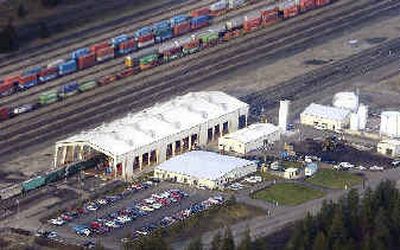Leak renews debate over rail depot

On Aug. 31, railroad officials opened the doors to a new refueling depot with a state-of-the-art containment system designed to ensure the safety of a massive drinking water supply below.
“It was emphasized repeatedly the fail-safe system they put in there,” said Buell Hollister, an environmental activist. “We went away from there really assured that they had a highly sophisticated system in place.”
But even before the tour, officials now say, an 8-inch plastic pipe apparently was fractured. The pipe carried wastewater with small amounts of diesel fuel and motor oil into the soil above the Spokane Valley-Rathdrum Prairie Aquifer.
For more than three months, the damage went undetected, and this week a state regulator said it appears diesel and oil leaked into the aquifer. With testing ongoing, it is unclear how much fuel leaked into the aquifer, which provides drinking water to more than 400,000 people in North Idaho and Eastern Washington.
The news resurrected a bitter dispute between supporters and critics of the 500,000-gallon refueling depot. In a string of public meetings in the spring of 2000, Burlington Northern and Santa Fe Railway Co. vigorously defended the plan to locate the depot above the aquifer. A hydrogeologist retained by the railroad testified the depot would not threaten the region’s drinking water.
Although soil samples indicated the waste breached the aquifer, a spokesman for BNSF said two test wells near the site did not show signs of contamination. Spokesman Gus Melonas said the railroad is checking a system of drainage pipes that carry 2,300 gallons of wastewater away from the depot each day.
Melonas confirmed high-pressure hoses were used to wash coolant, oil and diesel from the locomotives when they pulled in to refuel. That wastewater went into the drainage system, he said.
He emphasized that “BNSF is committed to a thorough investigation and remediation of the site.”
Marc Kalbaugh, a site remediation manager with the Idaho Department of Environmental Quality, said test results next week should reveal how much fuel went into the aquifer. Kalbaugh said preliminary soil tests confirmed the presence of contaminants such as benzene.
“Until we have the sample analysis back from an accredited laboratory, we will not be able to have a definitive discussion of the magnitude of this release,” Kalbaugh said.
Both the railroad and Idaho’s environmental department refused Tuesday to release the results of preliminary field studies.
Kootenai County Commissioner Dick Panabaker, who voted to allow the depot, said people were “overreacting” to news of the leak.
“There is a trace of it, not unlike what you’d find in a parking lot,” Panabaker said. “I think it’s grossly unfair to say this is a fuel spill.”
Panabaker said there was little reason to fear the depot would endanger the drinking water supply – now or in the future.
“This thing is a fluke,” Panabaker said. “The truth of the matter is you’d have to drop an atomic bomb on this to damage the aquifer.”
But for others, the fact that the depot developed a problem, and that it went undetected for so long, validated concerns about the siting of the facility.
“Why the decision-makers chose to allow that depot there in such a precarious situation – when you consider the potential impact to a half-million people – I will never understand it,” said Ken Lustig, the retired environmental director of the Panhandle Health District.
Lustig, who opposed the siting, said the regional health board instructed him not to provide testimony at the 2000 hearings, but allowed him to answer questions.
“From my professional perspective, it is an example of something that the community could have done very well without,” Lustig said. “That is not a good location for that activity. Period. Never was.”
Critics say they urged the railroad to build the depot six miles away from the current site, in an area that they say would not have threatened the water supply.
Stan Miller, who retired this year as Spokane County’s water resources manager, said his concern was not a catastrophic spill, but rather the gradual leaching of oil and fuel from the locomotives when they stopped to refuel.
While engineers worked to secure the fuel tanks, Miller worried about smaller leaks, including the wastewater pipe.
“It was the only thing that wasn’t really designed to not fail,” Miller said. “Everything else has double or triple containment. You wound up with a situation where a pipe that wasn’t supposed to be a problem was.”